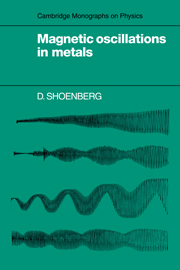Book contents
- Frontmatter
- Contents
- Preface
- List of symbols and abbreviations
- 1 Historical introduction
- 2 Theory
- 3 Observation of the de Haas–van Alphen effect
- 4 Other oscillatory effects
- 5 Fermi surfaces and cyclotron masses
- 6 Magnetic interaction
- 7 Magnetic breakdown
- 8 The Dingle temperature
- 9 Phase and spin-splitting
- Appendices
- Bibliography and author index
- Notes added in proof
- Subject index
1 - Historical introduction
Published online by Cambridge University Press: 07 October 2011
- Frontmatter
- Contents
- Preface
- List of symbols and abbreviations
- 1 Historical introduction
- 2 Theory
- 3 Observation of the de Haas–van Alphen effect
- 4 Other oscillatory effects
- 5 Fermi surfaces and cyclotron masses
- 6 Magnetic interaction
- 7 Magnetic breakdown
- 8 The Dingle temperature
- 9 Phase and spin-splitting
- Appendices
- Bibliography and author index
- Notes added in proof
- Subject index
Summary
Early history
Soon after J. J. Thomson's discovery of the electron in 1897, Drude (1900) showed that most of the characteristic features of a metal could be understood, at least qualitatively, by supposing that some of the electrons were able to move freely through the metal, and a few years later Lorentz worked out the theory more rigorously on the basis of classical statistical mechanics. The outstanding quantitative success of this Drude – Lorentz theory was the explanation it gave of the Wiedemann – Franz law, the proportionality to absolute temperature T, of the ratio of thermal to electrical conductivity. Moreover the predicted constant of proportionality came out close to the experimental value (though less close in Lorentz's more rigorous calculation). However the theory was quite unable to explain why the free electrons did not make a large contribution to the specific heat and later, when electron spin had been discovered, it was not clear why the free electrons did not contribute a large paramagnetic susceptibility varying as 1/T.
It is just over 50 years ago that Pauli (1927) made a major breakthrough by showing that if the recently discovered Fermi–Dirac statistics were used rather than classical statistics in working out the theory, the difficulty about spin susceptibility essentially disappeared. The calculated paramagnetic susceptibility then became independent of temperature and much feebler, roughly comparable to the experimental value.
- Type
- Chapter
- Information
- Magnetic Oscillations in Metals , pp. 1 - 21Publisher: Cambridge University PressPrint publication year: 1984
- 1
- Cited by



